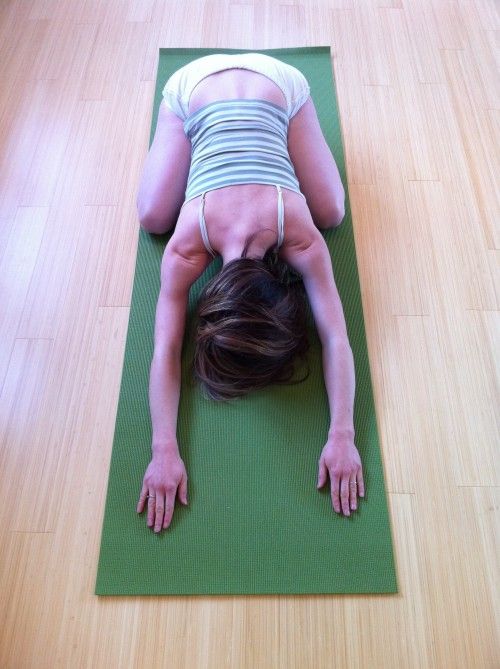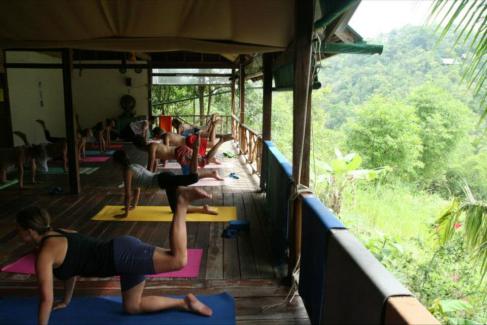Tag Archives: asana

5 Excuses Not to Practice at Home
5 Excuses Busted
1. I don’t have time.
There are times in life where you feel swamped and you don’t think you have time. But these are generally the times you need to practice the most. You don’t have to spend more than 10 minutes practicing. Set an alarm, do 10 minutes on your mat, and walk away. Time is a created thing. To say ‘I don’t have time’ is to say “I don’t want to.” ~ Lao Tzu
2. I start, and then I don’t know what I am doing, and give up.
Self-practice is not about mimicking your teachers hour long session. Choose a short and digestible amount—be it your own short sequence or a something specific your teacher has set for you, and do 10 minutes. If you feel lost, simplify and slowly rebuild. Chances are it’s your brain getting in the way. It’s a physical thing, so don’t intellectualize it. Move. Feel and breathe. That is all.
3. I can just go to a class.
Yes, you can, and classes are valuable. But the best relationships in life are reciprocal—your teacher teaches you, and you practice. Through self-practice you digest what you have done in class, and meet and overcome new blockages. This is an invaluable and necessary step forward if you want to truly dig into your yoga practice.
A short daily practice is better than a one-hour long practice in a week. It’s like brushing your teeth, and it is the continuity that will start to inform your practice and other aspects of your life.
Click to read two more excuses — YOGA
Krishnamacharya and The First Yoga Video
Via Yogacityny
This week I’m going to change things up a bit and write about the “Yoga: The Art of Transformation” exhibit down in DC. If you haven’t heard yet, the Freer | Sackler Museum at the Smithsonian put together a “leitmotif” of two thousand years of yoga art.
The exhibit is amazingly great, with weathered sculpture from ancient temples to miniature paintings from the medieval era to post-structuralist reinterpretations of the colonial-era photos of costumed-up ascetics. If you’re a yogi with a bent for art or history, be sure to catch it.
For me personally one of the key insights of the exhibition and its supporting scholarship was how instrumental photography and film have been in the development of “modern yoga”. Few of us probably know that the modern, postural yoga we practice today was developed only in the 1930 – 50s, by Krishnamacharya and his successors. Fewer still probably know the extent to which these pioneers relied on photography and film not just to popularize their redefined yoga but also to develop it.
Prior to the 1930s, there were some seated postures and austerities described in ancient texts and performed by ascetics, but nothing like the aerobic sequences taught by Krishnamacharya and Jois. When pre-modern artists weren’t depicting deities, they would draw the body conceptually, as a map of the universe or subtle energy channels, like the Chakras and Nadis.
Read more here — YOGA
Top 5 Books Every Yogi Should Read
I am constantly amazed how much there is to learn in studying yoga. Certified for seven years, I’ve barely reached the tip of knowledge involved in the complex world of yoga.
I believe every yogi should own these five books to refer to often.
1. Light On Yoga By B.K.S. Iyengar
This “bible” of yoga was the first yoga book I ever bought and by far I refer to it the most. It is often used during teacher trainings.
The definitive guide to the philosophy and practice of Yoga–the ancient healing discipline for body and mind–by its greatest living teacher. Light on Yoga provides complete descriptions and illustrations of all the positions and breathing exercises.
2. Yoga – The Practice Of Movement And Stillness By Eric Schiffman
Schiffman makes yoga approachable to those that may be intimidated or novices. He describes his own personal journey, which is uncommon for teachers.
The pictures, although black and white, are very clear and peaceful. He explains the exercises with step-by-step instructions and phases, so you can work upon a posture and build up to doing the full version. He also explains the benefits of each exercise in a little section following each one.
This book is very readable. It has a very easy style.
Click to see the other three important yoga books on Do You Yoga’s list.
Via Do You Yoga
La Yoga Shala in Milan, Italy
Cameron Alborzian: Yoga – Liberation From the Body
I first discovered yoga over 25 years ago. My discovery was like that of many others in the West who find their way into this world, in that it was defined by my pursuit of the physical postures. I was working out in a gym and wanted to distract myself with a new form of exercise. I would go to yoga studios in whatever city I was in and grunt my way through many different sequences that usually induced soreness and a lot of sweat. When others found out that I practiced yoga, the first question they usually asked was, “Where do you take yoga classes?” I might have told them that I practice at Integral Yoga, Sivananda Yoga, or Siddha Yoga. Some time later, I was asked if I ever did “that hot yoga,” which of course was an outsider’s way of asking if I practiced Bikram. I did take one class back in the ’90s to see what it was like, but never went back again.
What I experienced back then is very common on several levels. When someone in the West is introduced to yoga, it’s usually through the pursuit of the physical postures so commonly known today. Whether someone starts to go to yoga studios after work, takes classes at their gym, or even practices along with a video, they focus most of their attention on a physical routine. What is also common, however, is for one person to ask another person what style of yoga they practice. In this question, one embraces the idea that yoga postures aren’t a simple series of exercises that everyone does in a similar way. Their question is likely driven by their wanting to know whether the other person practices a routine inspired by Vinyasa yoga at a place like Jivamukti, Hatha yoga at a place like Integral Yoga, Kundalini at a place like Yoga West, or by specific personalities like B.K.S. Iyengar, Pattabhi Jois, or Bikram Choudhury. And while both people might recognize a shared interest in seeking this physical discipline as an ancient practice grounded in the most sacred spiritual traditions of the Indian tradition, if they practice different styles they likely see themselves as different categories of people as well.
In the years following my introduction to yoga postures, I found other ways to explore my practice. I went on retreats to obscure places in which we attempted to meditate, I committed myself to fasting, I sat in silence for weeks, and I chanted in community sessions like kirtans. But these efforts were far less consistent than the physical act of practicing postures — until about 10 or so years after my introduction. Over the years I had learned how the practice of yoga centers not on one of many different approaches to developing the body but on liberating the mind from the body. But I never found the discipline to truly pursue this aspect of it at the time. It was 10 years after my introduction when I went from doing yoga to following the yogic path.
An afflicted mind seeks the outer world to attain a sense of contentment and peace, which is evidenced by those of us who are excessive in our lifestyle. We mistakenly perceive that we will be happy if and when we get more things. But a similar sense of materialism can be assigned to those who attach themselves to a certain style of yoga postures. Postures were never supposed to become the centerpiece of the entire practice, and it was only through the ego that people started to focus on them. As a result, more postures have been invented in the last few centuries. While yoga as a tradition is intended to teach us how to liberate our mind from the body, through these attachments we’re trying as hard as possible to stay in it!
This conundrum underlines yoga’s importance. If we remain attached to a certain style of yoga postures, we remain attached to the material aspect of our existence. When we’re no longer attached to this aspect, we’re able to use yoga for its intended purpose and live in a state of supreme joy as a result. We’re able to enjoy the health and vitality that a balanced physical regimen inspires, but we don’t get attached to one specific approach to that regimen over the other. We look at postures, meditation, and everything else born from these traditions as tools for ending a perpetual state of suffering and moving closer to pure consciousness. And once we attain that state, we no longer concern ourselves with whether someone practices the same style as us or not. We move from using a physical exercise to become spiritual to knowing we are spiritual and using the physical aspect to keep our body as healthy as possible. With a healthy body, we’re able to practice our spirituality.
But why has this happened? Why has Western culture taken one part of a spiritual practice and made it just as material as a regimen that sculpts one’s body into a perfect shape? We live such material lives because we live at a time of greatest material density. In my next blog, I will explain how this has come to pass.
What is Asana?
Asana is a Sanskrit word that loosely translates as “poses” or “postures” in English. Asana is one of the eight limbs of Ashtanga yoga. When the average Westerner thinks of yoga, they think of the asanas.
It’s great to see that so many Westerners are finding yoga but we also feel that as a result, yoga has become somewhat commercialized and diluted. For example, ask the average Westerner what comes to mind when they think of yoga and their answer might be, “The girl from Lulu Lemon’s advertising.” Or they might associate asana with other “classes” offered at their local gym such as Zumba or pilates. However, at Lucid Practice, we adhere more to the Eastern approach when viewing asana.
Through the daily, consistent practice of asanas with proper breathing, the practitioner purifies body and mind. You begin to feel a new source of energy and become more aware of your surroundings and your own inner being. We grant ourselves the ability to truly concentrate. The ultimate purpose of asana is to prepare the body and mind for meditation.
Click to read more about our views on the other limbs of yoga specifically the yamas and niyamas.
What’s your definition of asana?


